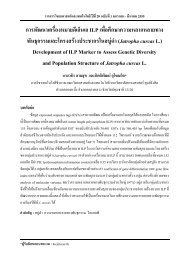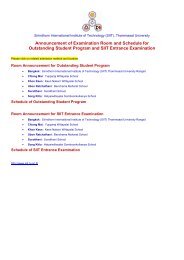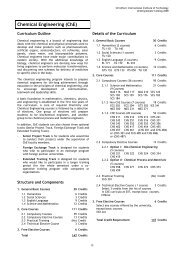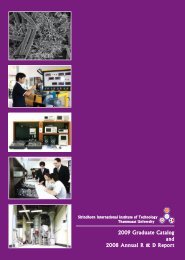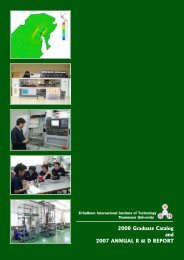<strong>10</strong> <strong>Years</strong> <strong>of</strong> <strong>International</strong> Cooperation: FTI, Nippon Keidanren and TU<strong>SIIT</strong> <strong>Commemorative</strong> <strong>Publication</strong>, 2002control approach are not easy to implement. Forexample, it is recommended that workers rotate amongworkstations to reduce their daily noise exposurelevels. Since there are numerous combinations <strong>of</strong> workassignments to consider, it is almost impossible for thesupervisor to find the optimal work assignmentsolution.An Excel-based computer program called “NoiseManager” is developed to assist safety practitioners topractically implement several recommendations basedon the administrative approach. Noise Manager can beused to evaluate existing noise conditions andrecommend practical solutions. It consists <strong>of</strong> eightmodules. The first four modules are for noiseevaluation and the last four are for noise management.The user can select the preferred module from themenu as shown in Fig. 190n ⎡ L j − ⎤D T = 12.5 C 25∑⎢ ⎥j(2)j=1⎢ ⎥⎣ ⎦3.2 Module 2 – Calculation <strong>of</strong> Noise Level andPermissible Duration at any LocationTo predict the combined noise level at any location,Noise Manager needs information such as the ambientnoise level, noise levels <strong>of</strong> all noise sources in the workarea, and the locations (in x and y coordinates) <strong>of</strong> thosenoise sources. The following formula can be used todetermine the combined noise level at location i ( L i ).L i =⎡n ( Lj−120)/<strong>10</strong>( 120)/<strong>10</strong> <strong>10</strong> ⎤Lab−<strong>10</strong>log ⎢<strong>10</strong> + ∑ ⎥+1202⎢⎣j=1 dij⎥(3)⎦where d ij is the distance between location i and noisesource j, L j the noise level <strong>of</strong> noise source j, and L ab theambient noise level.If the worker is required to be at one location for theentire day, it is possible to determine the permissibleexposure time (T) at that location from the known noiselevel.−1−90⎡ L ⎤5T = 8(4)⎢2⎣⎥⎦Fig. 1 Noise Manager and its modules.3.1 Module 1 – Calculation <strong>of</strong> TWA and Noise Dose<strong>of</strong> an 8-hour DayA time-weighted average (TWA) is an index thatmeasures the amount <strong>of</strong> long-term noise exposure. Todetermine the 8-hour TWA, Noise Manager needs toknow the noise levels at the locations that the worker ispresent and the exposure duration at those locations. Itthen uses the following formula to calculate the 8-hourTWA (W) in dBA,3.3 Module 3 – Construction <strong>of</strong> Noise Contour Map<strong>of</strong> a FacilityA noise contour map depicts noise levels at variouslocations in the work area. Usually, locations that havethe same noise level are connected together by thesame contour line. To analytically construct a noisecontour map, Eq. (3) can be used to determine thecombined noise level. Figure 2 shows an example <strong>of</strong> a3-dimensional noise contour map constructed by NoiseManager.W =⎡ ⎧90nLC ⎛ j − ⎞⎫⎤j16.61⎢ ⎪log ⎜2 5 ⎟ ⎪⎥+ 90⎢ ⎨∑ ⎬(1)j=1 8 ⎜ ⎟ ⎥⎢ ⎪ ⎝ ⎠⎪⎣ ⎩⎭⎥⎦where C j and L j are the exposure duration and thecombined noise level at workstation j, respectively.The daily noise dose (D T ), in percent, can also becalculated using the same data. The daily noise doseand the 8-hour TWA present similar information aboutthe noise condition (Nanthavanij 1998).Fig. 2 A noise contour map.78
<strong>10</strong> <strong>Years</strong> <strong>of</strong> <strong>International</strong> Cooperation: FTI, Nippon Keidanren and TU<strong>SIIT</strong> <strong>Commemorative</strong> <strong>Publication</strong>, 20023.4 Module 4 – Estimation <strong>of</strong> Ambient andMachine Noise LevelsThe important pieces <strong>of</strong> information that are verydifficult to obtain are the ambient noise level and thenoise levels <strong>of</strong> noise sources in the work area. This isbecause it is not practical to shut <strong>of</strong>f all other noisesources so that the noise level <strong>of</strong> the given noise sourcecan be separately measured. Noise Manager allows theuser to conveniently estimate the wanted information.It uses a simple linear algebra approach to set up a set<strong>of</strong> linear equations in which the ambient noise andmachine noise levels are unknown variables. Theequations are then simultaneously solved to determinethe unknown variables.Note that in order to solve for the ambient noise leveland the noise levels <strong>of</strong> n sources, n + 1 known noiselevels are required. In practice, any locations in thework area may be chosen for noise measurements. It ishowever recommended that the locations that are farfrom the wall or corner be chosen to avoid the effect <strong>of</strong>sound reflection.3.5 Module 5 – Determination <strong>of</strong> Minimax WorkAssignments (Heuristic)The minimax work assignments are the assignmentsdeveloped for m workers, n workstations, and p workperiods per day. Generally the assignment will specifythat “who will do what during when.” According toNanthavanij and Yenradee (1999b), the minimax workassignments are a set <strong>of</strong> work assignments that themaximum noise level that any <strong>of</strong> the workers receive isminimized. Noise Manager determines the minimaxwork assignments based on the heuristic approachdeveloped by Tarathorn and Nanthavanij (underreview). It can solve both balanced (m = n) andunbalanced (m > n) problems, and both unconstrainedand constrained problems.Figure 3 shows the data and the minimax workassignments determined by Noise Manager. When thenumber <strong>of</strong> workers is greater than the number <strong>of</strong>workstations, some workers will be idle in some workperiods. Also, note that the maximum noise exposurelevel may be beyond 90 dBA.The mathematical model <strong>of</strong> the complex workassignment model can be described as follows. Let a ijrepresent a component <strong>of</strong> a matrix A that definesworker-workstation feasible assignments, where a ij = 1if worker i can be assigned to workstation j, and a ij = 0Lj−901otherwise. The term 25is viewed as a noisepweight per period <strong>of</strong> a given workstation j (or w j ). Anyworker who is assigned to that workstation will alwaysreceive that amount <strong>of</strong> noise weight.Minimizesubject toZ⎡ ⎧ n p⎪ ⎫⎪⎤16.61⎢log<strong>10</strong>⎨ wx j ijk⎬⎥+90⎢⎣⎪⎩j= 1k=1 ⎪⎭⎥⎦nxijkj=1∑∑ ≤ Z, i = 1,…, m∑ ≤ 1 i = 1,…, m; k = 1,…, pm∑ x ijki=1m pxijki= 1k=1≤ 1∑∑ ≤ p j = 1,…, nx ijk ≤ a ijx ijk = 0, 1}j = 1,…, n; k = 1,…, pi = 1,…, m; j = 1,…, n; k = 1,…, pi = 1,…, m; j = 1,…, m; k = 1,…, pThe number <strong>of</strong> possible work assignments (orsolutions) is equal to (m!) p . For a small workassignment problem in which there are five workers(m = 5) and a workday is divided into four workperiods (p = 4), there are 207,360,000 assignments toconsider.Fig. 3 Input data screen and the work assignment solution.79
- Page 2 and 3:
!" Years of International Cooperati
- Page 5 and 6:
1993: Her Royal HighnessPrincess Ma
- Page 7 and 8:
!"#$%&'(#)*#+,-%',&-.),&/#0))1%'&-.
- Page 9 and 10:
!"#$%&'(#)*#+,-%',&-.),&/#0))1%'&-.
- Page 11 and 12:
!"#$%&'(#)*#+,-%',&-.),&/#0))1%'&-.
- Page 13 and 14:
!"#$%&'(#)*#+,-%',&-.),&/#0))1%'&-.
- Page 15 and 16:
!!!"#$%&'(#)*#+,-%',&-.),&/#0))1%'&
- Page 17 and 18:
!!!"#$%&'(#)*#+,-%',&-.),&/#0))1%'&
- Page 19 and 20:
!!"#$%&'(#)*#+,-%',&-.),&/#0))1%'&-
- Page 21 and 22:
!!"#$%&'(#)*#+,-%',&-.),&/#0))1%'&-
- Page 23 and 24:
"#!$%&'(!)*!+,-%',&-.),&/!0))1%'&-.
- Page 25 and 26:
!!"#$%&'(#)*#+,-%',&-.),&/#0))1%'&-
- Page 27 and 28:
!"#$%&'(#)*#+,-%',&-.),&/#0))1%'&-.
- Page 29 and 30:
!"#$%&'(#)*#+,-%',&-.),&/#0))1%'&-.
- Page 31 and 32:
!"#$%&'(#)*#+,-%',&-.),&/#0))1%'&-.
- Page 33 and 34:
!"#$%&'(#)*#+,-%',&-.),&/#0))1%'&-.
- Page 35 and 36:
!"#$%&'(#)*#+,-%',&-.),&/#0))1%'&-.
- Page 37 and 38:
10 Years of International Cooperati
- Page 39 and 40:
10 Years of International Cooperati
- Page 41 and 42:
10 Years of International Cooperati
- Page 43 and 44:
10 Years of International Cooperati
- Page 45 and 46:
10 Years of International Cooperati
- Page 47 and 48:
10 Years of International Cooperati
- Page 49 and 50:
10 Years of International Cooperati
- Page 51 and 52:
10 Years of International Cooperati
- Page 53 and 54:
10 Years of International Cooperati
- Page 55 and 56:
10 Years of International Cooperati
- Page 57 and 58:
10 Years of International Cooperati
- Page 59 and 60:
10 Years of International Cooperati
- Page 61 and 62:
10 Years of International Cooperati
- Page 63 and 64: 10 Years of International Cooperati
- Page 65 and 66: !!"#$%&'(#)*#+,-%',&-.),&/#0))1%'&-
- Page 67 and 68: !!"#$%&'(#)*#+,-%',&-.),&/#0))1%'&-
- Page 69 and 70: #!"#$%&'(#)*#+,-%',&-.),&/#0))1%'&-
- Page 71 and 72: #!"#$%&'(#)*#+,-%',&-.),&/#0))1%'&-
- Page 73 and 74: #!"#$%&'(#)*#+,-%',&-.),&/#0))1%'&-
- Page 75 and 76: 10 Years of International Cooperati
- Page 77 and 78: 10 Years of International Cooperati
- Page 79 and 80: 10 Years of International Cooperati
- Page 81 and 82: 10 Years of International Cooperati
- Page 83 and 84: 10 Years of International Cooperati
- Page 85 and 86: 10 Years of International Cooperati
- Page 87 and 88: !!"#$%&'(#)*#+,-%',&-.),&/#0))1%'&-
- Page 89 and 90: !!!"#$%&'(#)*#+,-%',&-.),&/#0))1%'&
- Page 91 and 92: !"#!$%&'(!)*!+,-%',&-.),&/!0))1%'&-
- Page 93 and 94: !"#!$%&'(!)*!+,-%',&-.),&/!0))1%'&-
- Page 95 and 96: !"#!$%&'(!)*!+,-%',&-.),&/!0))1%'&-
- Page 97 and 98: !"#$%&'(#)*#+,-%',&-.),&/#0))1%'&-.
- Page 99 and 100: !"#$%&'(#)*#+,-%',&-.),&/#0))1%'&-.
- Page 101 and 102: !!"#$%&'(#)*#+,-%',&-.),&/#0))1%'&-
- Page 103 and 104: !!"#$%&'(#)*#+,-%',&-.),&/#0))1%'&-
- Page 105 and 106: !!"#$%&'(#)*#+,-%',&-.),&/#0))1%'&-
- Page 107 and 108: 10 Years of International Cooperati
- Page 109 and 110: !!"#$%&'(#)*#+,-%',&-.),&/#0))1%'&-
- Page 111 and 112: !!"#$%&'(#)*#+,-%',&-.),&/#0))1%'&-
- Page 116 and 117: !"#$%&'(#)*#+,-%',&-.),&/#0))1%'&-.
- Page 118 and 119: !"#$%&'(#)*#+,-%',&-.),&/#0))1%'&-.
- Page 120 and 121: !"#$%&'(#)*#+,-%',&-.),&/#0))1%'&-.
- Page 122 and 123: !"#$%&'(#)*#+,-%',&-.),&/#0))1%'&-.
- Page 124 and 125: !"#$%&'(#)*#+,-%',&-.),&/#0))1%'&-.
- Page 126 and 127: !"#$%&'(#)*#+,-%',&-.),&/#0))1%'&-.
- Page 128 and 129: !"#$%&'(#)*#+,-%',&-.),&/#0))1%'&-.
- Page 130 and 131: !"#$%&'(#)*#+,-%',&-.),&/#0))1%'&-.
- Page 132 and 133: !"#$%&'(#)*#+,-%',&-.),&/#0))1%'&-.
- Page 134 and 135: !"#$%&'(#)*#+,-%',&-.),&/#0))1%'&-.
- Page 136 and 137: !!"#$%&'(#)*#+,-%',&-.),&/#0))1%'&-
- Page 138 and 139: !!"#$%&'(#)*#+,-%',&-.),&/#0))1%'&-
- Page 140 and 141: !!"#$%&'(#)*#+,-%',&-.),&/#0))1%'&-
- Page 142 and 143: !!"#$%&'(#)*#+,-%',&-.),&/#0))1%'&-
- Page 144 and 145: !!"#$%&'(#)*#+,-%',&-.),&/#0))1%'&-
- Page 146 and 147: !!"#$%&'(#)*#+,-%',&-.),&/#0))1%'&-
- Page 148 and 149: !!"#$%&'(#)*#+,-%',&-.),&/#0))1%'&-
- Page 150 and 151: !!"#$%&'(#)*#+,-%',&-.),&/#0))1%'&-
- Page 152 and 153: !"#!$%&'(!)*!+,-%',&-.),&/!0))1%'&-
- Page 154 and 155: "#!$%&'(!)*!+,-%',&-.),&/!0))1%'&-.
- Page 156 and 157: !!"#$%&'(#)*#+,-%',&-.),&/#0))1%'&-
- Page 158 and 159: !"#$%&'(#)*#+,-%',&-.),&/#0))1%'&-.
- Page 160 and 161: #!"#$%&'(#)*#+,-%',&-.),&/#0))1%'&-
- Page 162 and 163: Access to SIIT at Bangkadi!!!",':!D




